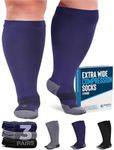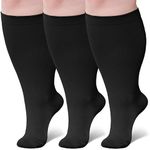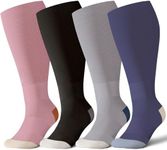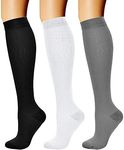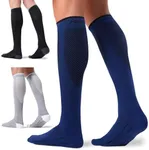Buying Guide for the Best Wide Calf Compression Socks For Nurses
When choosing wide-calf compression socks for nurses, it's important to consider several key specifications to ensure you get the best fit and functionality for your needs. Compression socks are designed to improve blood flow, reduce swelling, and provide support during long hours of standing or walking, which is common in the nursing profession. By understanding the key specs, you can make an informed decision and select the right pair of compression socks that will offer comfort and support throughout your demanding workday.Compression LevelCompression level refers to the amount of pressure the socks apply to your legs, measured in millimeters of mercury (mmHg). This spec is important because it determines how effective the socks will be in improving blood circulation and reducing swelling. Compression levels are typically divided into light (8-15 mmHg), moderate (15-20 mmHg), firm (20-30 mmHg), and extra firm (30-40 mmHg). For nurses, a moderate to firm compression level (15-30 mmHg) is usually recommended, as it provides adequate support for long hours on your feet without being too restrictive.
Calf SizeCalf size is the circumference of your calf, which is crucial for ensuring a proper fit. Wide-calf compression socks are designed to accommodate larger calf sizes, providing comfort and effectiveness. To navigate this spec, measure the widest part of your calf and compare it to the sizing chart provided by the manufacturer. Socks that are too tight can cause discomfort, while those that are too loose may not provide the necessary compression. Choose a size that matches your calf measurement to ensure optimal support and comfort.
MaterialThe material of compression socks affects their breathability, durability, and comfort. Common materials include nylon, spandex, and cotton blends. This spec is important because it influences how the socks feel on your skin and how well they perform over time. For nurses, breathable and moisture-wicking materials are ideal, as they help keep your feet dry and comfortable during long shifts. Look for socks with a blend of nylon and spandex for a good balance of stretch, support, and breathability.
LengthLength refers to how high the socks go up your leg. Compression socks come in various lengths, including ankle, calf, and knee-high. This spec is important because it determines the area of your leg that will receive compression. For nurses, knee-high compression socks are often the best choice, as they provide support to the entire lower leg, which is beneficial for reducing swelling and improving circulation during long periods of standing or walking.
Toe StyleToe style refers to whether the socks have an open or closed toe. This spec is important for comfort and personal preference. Closed-toe socks provide full coverage and are suitable for colder environments, while open-toe socks allow for more breathability and can be more comfortable in warmer conditions. Consider your work environment and personal comfort when choosing between open or closed-toe styles.
DurabilityDurability refers to how well the socks hold up over time with regular use and washing. This spec is important because it affects the longevity and cost-effectiveness of the socks. Look for compression socks with reinforced heels and toes, as these areas are prone to wear and tear. High-quality materials and construction will ensure that the socks maintain their compression and support even after multiple washes. For nurses, durable socks are essential to withstand the demands of daily wear.



